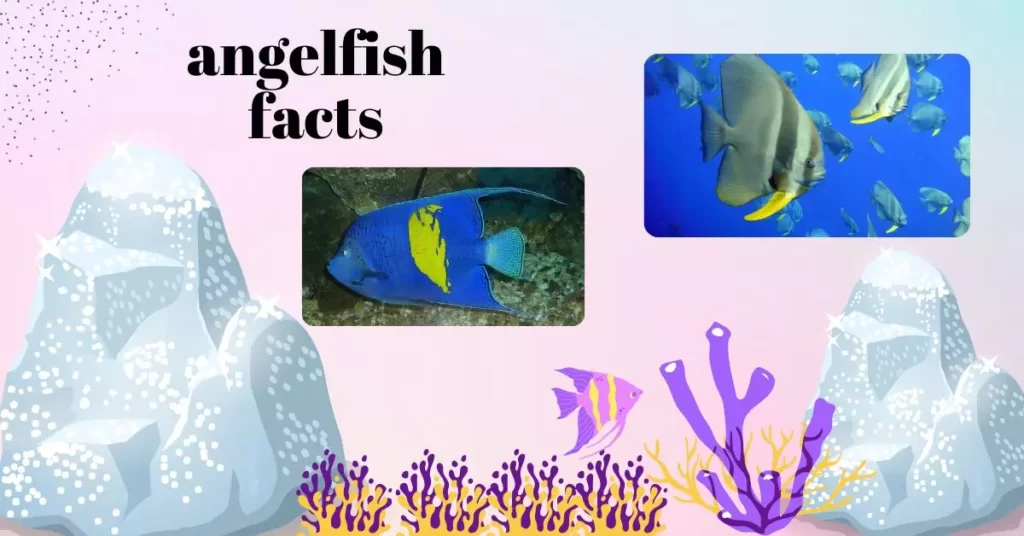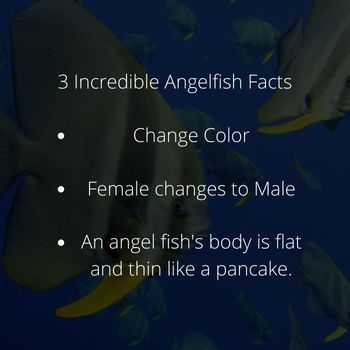Angel fish is a freshwater fish. Most people prefer angelfish as a pet but they don’t know these incredible angelfish facts. These fishes are one of the most common pet fish in the world.
Pterophyllum is a small species of freshwater fish in the Cichlidae family known to most aquarists as angelfish. All Pterophyllum species originate from various rivers in tropical South America in the Amazon basin, Orinoco basin and Giana Shield.
Angelfish Scientific Classification:

Common Angelfish Facts:

There are so many common angelfish facts on the Internet. But we discussed these angelfish facts very shortly.
Main prey: sponges, algae
Group Behavior: Social
Fun fact: 95% of angelfish eat sponges
Estimated population size: Unknown
The biggest threat: water pollution
Most distinctive feature: Brightly colored scales
Gestation period: 1-3 days
Water Type: Salt
Optimum pH level: 6.5 – 7.2
Residence: Prabaldwip
Predators: Large fish, barracudas, sharks
Diet: Omnivorous
Favorite Food: Fish
Type: Perciformes
Common Name: Angelfish
Number of species: 90 species
Species: There are 70 different species!
You can read our latest post: unknown and interesting facts about flying fish
Physical Characteristics of Angelfish:
Color: Yellow, Blue, Black, White, Green
Skin Type: Scaly
Lifespan: Up to 15 years
Weight: Up to 2 lbs
Length: 8 to 12 inches
Angelfish are known for their brightly colored scales. There are 90 different species of marine angelfish. This omnivorous fish lives in the Indian, Atlantic and western Pacific oceans. They swim and play in and out of coral reefs.
3 Incredible Angelfish Facts!
Angel fish has many interesting and common facts but we are discuss about the main incredible Angelfish Facts.

Color Change:
The most interesting fact about this fish is that it changes color as it ages. For example, a young angelfish’s black stripes may fade to yellow as it ages. Health, nutrition and reproductive activity can also cause color changes.
Change of female to male:
Angelfish are known as protogynous hermaphrodites. It means a woman changes to a man at a certain point in her life.
A pancake shape:
An angel fish’s body is flat and thin like a pancake. This allows them to slip through cracks and narrow holes in a coral reef. They can thus escape predators or access algae or other plant life for nutrients.
Classification and Scientific Names of Angelfish:
The scientific name of marine angelfish is Pomacanthidae. The word Pomacanthidae is Greek for ‘thorns.’ It refers to the spiny growths on the body of all angelfish. Spiny growths may be on its head or near the tailfin. It belongs to the family Pomacanthidae and class Actinopterygii.
Angelfish Breed:
- Emperor angelfish
- Queen Angelfish
- French angelfish
- Blue angelfish
There are 90 species of this fish. Their family is divided into 7 clans. Many angelfish live near coral reefs. Many of these coral reefs are located in the Caribbean Sea.

1: Emperor Angelfish:
This fish is one of the larger species at 15.75 inches long. Adults are easily recognized by their vivid blue and yellow stripes. It feeds on sponges and algae on and around coral reefs.
2: Queen Angelfish:
This fish, sometimes known as the Blue Queen, is another large species measuring 18 inches in length. They are blue and yellow in color. Sponge is the main food of this fish. It also eats jellyfish.
3: French Angelfish:
A French angelfish is black in color with distinctive rings of yellow around the eyes. They lives in the eastern Caribbean on the coral reefs. Like most species, sponges are the main food of this fish.
Read More: Different species of barb fish
Appearance of Angelfish:
Angel fish are red, blue, green, black or yellow in color or combination of these colors. Some marine angelfish have scales with swirling color patterns, others have stripes, and others are mostly solid colors.
They have feathery pectoral fins with black eyes and a small mouth. All angelfish have spines or spiny growths somewhere on their bodies. For example, koi angelfish are only 6 inches long.
The largest species is the gray angelfish. This fish can grow up to 24 inches in length and weigh up to 4 pounds! The fish’s thin, flat body allows it to slide into hard-to-reach places, which may help it escape some of its predators.
Plus, most of these fish feature bright colors so you’d think they’d be easy for predators to spot.
However, they are able to blend in with brightly colored rocks, algae and other features in their coral reef habitat. French angelfish (Pomacanthus paru) and red coral reef swimming.
You can read our latest post, Shrimp Names in different different Language
Angelfish Lifespan and Breeding:
These fish are born in the winter season. They are polygamous (have multiple partners). Males flap their pectoral fins to attract females.
Larvae live on algae and plankton as they develop into adult fish. Although the larvae are clean, they are vulnerable to being eaten by small or large fish that pass by.
This is why angelfish have so many eggs. Thus, at least some are likely to survive into adulthood.
Mothers and fathers do not bond with their young after hatching as eggs. An angelfish has a lifespan of up to 15 years.
FAQ (Frequently Asked Questions):
Where are angelfish found?
This omnivorous fish lives in the Indian, Atlantic and western Pacific oceans. They swim and play in and out of coral reefs.
What do wild angelfish eat?
One of the main facts to remember about these fish is that they are omnivores. These fish feed on sponges, shrimp fragments and algae. Larger species of these fish are capable of consuming larger prey. The conservation status of most species is of minimal concern with stable populations.
How long do angelfish live?
The life span of this fish can go up to 15 years.
Are angelfish aggressive?
Yes and no. Angelfish can be very aggressive with other angelfish in the aquarium especially if it is not a large enough habitat.
For example, keeping a koi angelfish in an aquarium with another angelfish can lead to fighting. It’s best to research what types of fish can be safely paired with.
Also, although they travel through the ocean in small groups, angelfish fight and challenge each other in territory.
Angelfish predators?
Some of their predators include large fish, sharks and barracudas. These are all animals that share habitat with these fish.
Angelfish belong to which kingdom?
Angelfish belongs to the Kingdom Animalia.
Which phylum does angelfish belong to?
Angelfish belong to the phylum Chordata.
What class does angelfish belong to?
Angelfish belong to the class Actinopterygii.
Angelfish belong to which family?
Angelfish belong to the Pomacanthidae family.
Which order does Angelfish belong to?
Angelfish belong to the order Perciformes.
What type of coating does an angelfish have?
Angelfish are covered in scales.
What is the main prey of angelfish?
Angelfish prey on sponges and algae.
What is an interesting fact about angelfish?
There are 70 different species of angelfish!
What is a distinguishing feature of angelfish?
Bright appearance of angelfish.
SOURCES:
